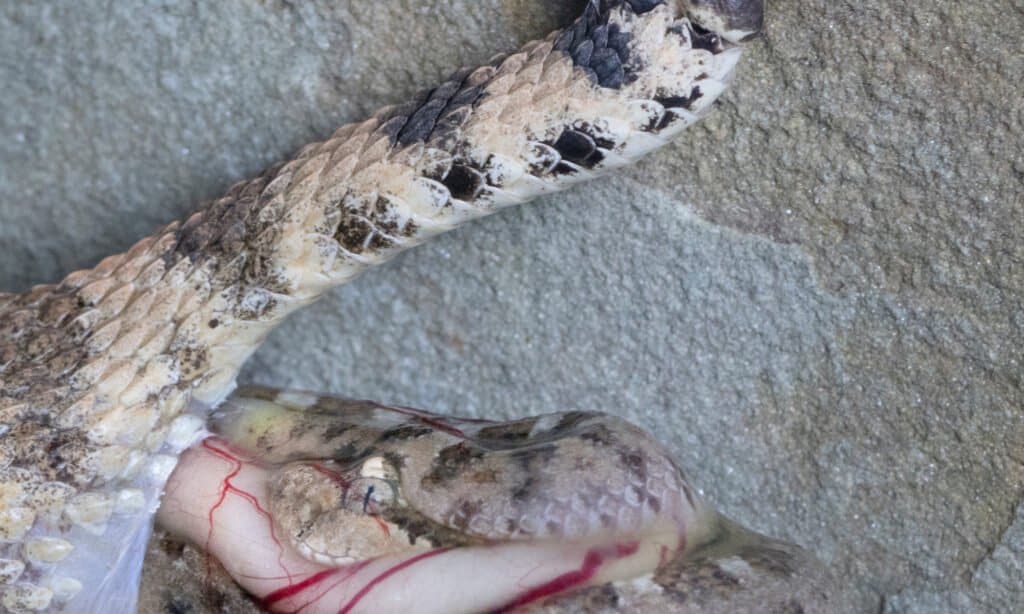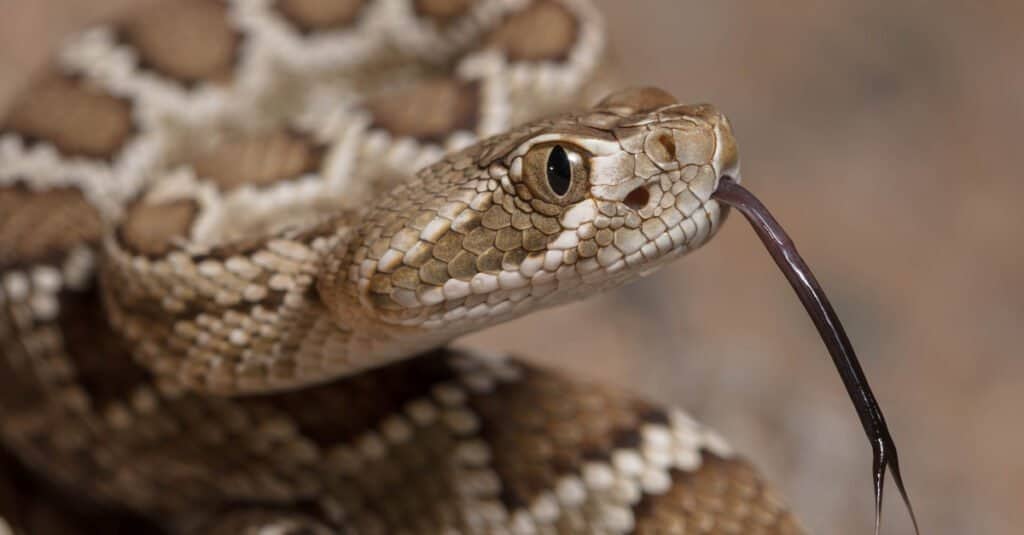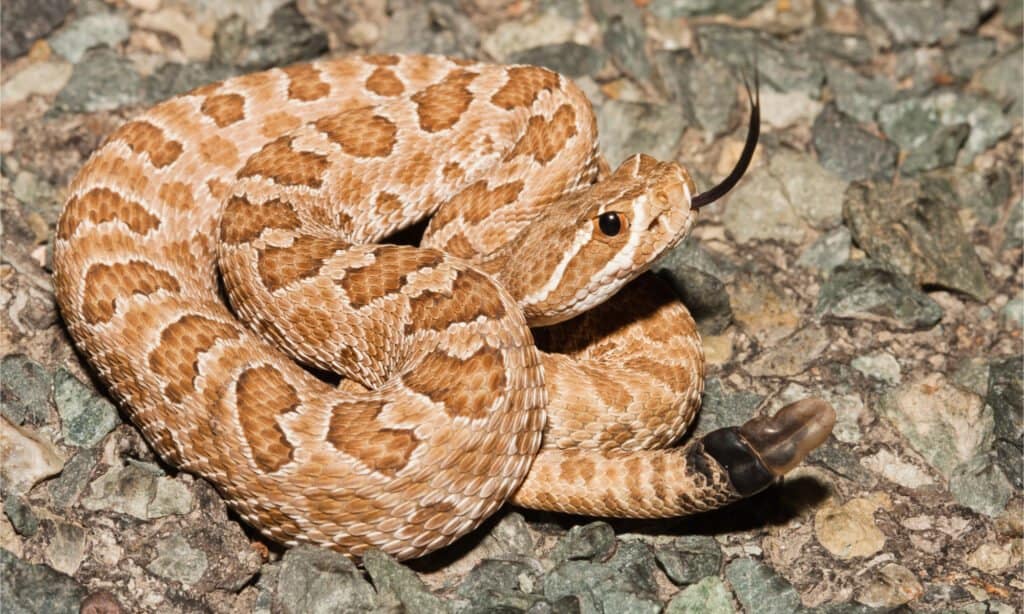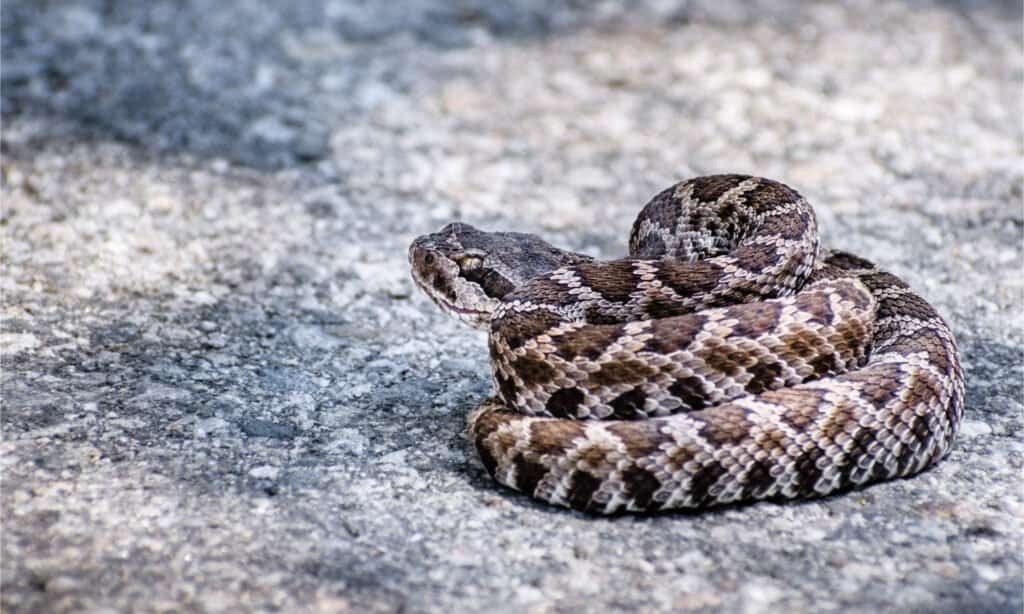Rattlesnakes, so named for the famous rattle at the end of their tails, are some of the most feared snakes on the planet. Like most reptiles, they’re cold-blooded and rely on the warmth of the sun to keep their bodies warm. But, the big question is: do rattlesnakes lay eggs? Other types of reptiles, like crocodiles and alligators, lay clutches of eggs which they tend and keep warm until the babies are ready to hatch, but just how do rattlesnakes raise their young?
Rattlesnakes are members of the New World viper family; they’re classified as pit vipers. There are 33 species of rattlesnakes living throughout North America, as far north as southern Canada, and as far south as Argentina. Some species, like the pygmy rattlesnake, grow to only two feet in length, while other species, like the eastern diamondback, can exceed eight feet long. Each species has its own variations on reproduction, but they all make baby snakes in essentially the same way.
Here, we’ll learn just how rattlesnakes reproduce. Then, we’ll take a look at the best times of year for finding newborn snakes, and how to avoid them. We’ll take a deep dive into the rattlesnake’s mothering instinct, and explore just how many babies each female has at once. Then, we’ll go over what you should do if you encounter a baby rattlesnake. Finally, we’ll go over why rattlesnakes are vital to the ecosystem, and why you should treat any rattlesnake you find with respect and caution.
Rattlesnake Reproduction: Making More Snakes

A rattlesnake giving birth to a baby.
©Mark_Kostich/Shutterstock.com
Some species of rattlesnake mate in the fall, while others mate in the spring. Regardless of the time of year that mating takes place, baby snakes are generally born in late spring to early summer. If mating takes place in the spring, female snakes immediately use the sperm to fertilize the eggs growing inside them. However, if mating takes place in the fall, the female snake actually keeps the sperm in a special organ until after the winter has passed, then her body uses it to fertilize her eggs.
Yes, rattlesnakes have eggs, but they don’t lay them. It may sound confusing, but rattlesnakes are actually ovoviviparous, like some species of cockroach. This means that the eggs incubate inside the female and when they’re ready to hatch, the eggs hatch inside the mother. She then gives birth to live young.
Most species of rattlesnake only give birth every three or so years, but some reproduce every year. Most live to be around ten years old, though some captive rattlesnakes have lived for over twenty years.
What Time of Year Do Rattlesnakes Give Birth?

Baby rattlesnakes are born in the late summer or early fall.
©Alexander Wong/Shutterstock.com
Each species of rattlesnake has its own lifecycle. Some have their babies in the spring, some in the fall, and still others at the height of summer. The time of year that baby snakes are born depends largely on the local climate. Most species, including eastern and western diamondbacks, give birth in late summer or early fall.
How Many Babies Can a Rattlesnake Have at Once?

Most of the time, rattlesnakes give birth to 8-15 babies at once.
©Nathan A Shepard/Shutterstock.com
The number of babies a female rattlesnake has depends on many factors, including the snake’s age, the weather, her health, and how much she gets to eat during pregnancy. Generally though, rattlesnakes birth between 8-15 young per pregnancy. Rattlesnakes don’t lay eggs, instead, they give birth to live young sometime in the spring, summer, or fall.
Do Rattlesnakes Stay with Their Eggs?
Female rattlesnakes often hide away in dens up to a month before they birth their young. The baby snakes stay around the den for up to a week or two after birth. During that time, the mother frequently sticks around, though she doesn’t do much mothering. At this stage of life, the baby snakes are extremely vulnerable—they have venom, but can’t yet rattle. Plus, they’re so small (under ten inches long) that they make an easy meal for creatures like roadrunners, king snakes, and wild pigs.
Most baby rattlesnakes don’t make it to adulthood; many of them are eaten, and more starve to death. The mother snake leaves the birthing den within a week or two of giving birth, after that she has nothing to do with the baby snakes. So, while mother rattlesnakes don’t stay with their eggs (since the eggs hatch during pregnancy), they do hang out with their babies for a while before leaving to make more snakes.
What to Do if You Find a Baby Rattlesnake

It’s best to avoid baby rattlesnakes if encountered.
©Sundry Photography/Shutterstock.com
In good conditions, in the right places, baby rattlesnakes are plentiful in the early fall. They may be so small that you don’t even notice them. However, if you do find a baby rattlesnake, don’t approach it. If you like snakes, they may even look cute—don’t try to touch them. They may not have rattles yet, but they do have venom. It’s not true that baby rattlesnakes are more dangerous than adults, but they can still be the cause of a hospital visit.
Instead of approaching the baby rattlesnake, stay calm, don’t make any sudden moves, and move away slowly. Be sure to stay at least a few feet from the baby snake if you need to pass by. No matter how old they are, all rattlesnakes can coil and strike to deliver a venomous bite.
Why Do We Need Rattlesnakes?
You’re not likely to find a rattlesnake egg anytime soon, but it’s important to know why rattlesnakes are such a vital part of the ecosystem. If it weren’t for rattlesnakes, rodent populations would grow too populous, and eat all the grasses and forbs in sight, leaving nothing behind for the rest of the creatures in the environment. Remove rattlesnakes, and you risk upsetting the natural balance of the local ecosystem. This is especially true in fragile environments, like the desert southwest of North America.
The photo featured at the top of this post is © Ryan M. Bolton/Shutterstock.com
Discover the "Monster" Snake 5X Bigger than an Anaconda
Every day A-Z Animals sends out some of the most incredible facts in the world from our free newsletter. Want to discover the 10 most beautiful snakes in the world, a "snake island" where you're never more than 3 feet from danger, or a "monster" snake 5X larger than an anaconda? Then sign up right now and you'll start receiving our daily newsletter absolutely free.
Thank you for reading! Have some feedback for us? Contact the AZ Animals editorial team.






